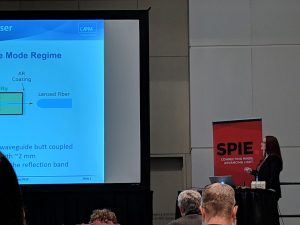
SPIE Photonics West is one of the world’s largest annual conferences for the photonics, laser and biomedical optics industries. The event consisted of three conferences and two world class exhibitions, which took place in San Francisco, California, from 2nd to the 7th of February 2019. Photonics West consisted of a week of cutting-edge research consisting of over 5,000 presentations and two world class exhibitions of over 1,300 companies with over 20,000 in attendance. Dr Dzianis Saladukha, Sharon Butler and Uday Bangavadi Munivenkatappa represented CAPPA at the conference.
Sharon Butler spoke about “Direct frequency modulation of photonic crystal laser by thermal tuning with low-intensity modulation.” Frequency modulated lasers have a wide range of applications in bio-medical imaging, LIDAR, sensing and optical communications. As silicon photonics has become one of the promising technologies for optical communications, we demonstrate a frequency modulated III-V hybrid external cavity Si photonic crystal laser which can also be exploited for sensing technology. As the lasing wavelength can be precisely controlled by the silicon thermo-optic effect and due to the low intensity modulation output of this laser, it can be an ideal candidate for trace gas detection where precise wavelength registration is essential.
Uday Bangavadi Munivenkatappa spoke about “Stable and unstable Nozaki-Bekki holes in a long laser.” Long-cavity fibre based wavelength sweeping lasers are promising devices for medical imaging applications. The coherence properties of such swept-sources are of major importance as they define the image quality. The purpose of this work is to analyze the mechanism that deteriorates the coherence of long lasers. In the experiment, the laser demonstrated different dynamical regimes as a function of the injection power and an unstable Nozaki-Bekki holes that lead to CW and chaotic operation. Such a behavior indicates that it is possible to optimize the injection current and carrier decay rate in order to obtain highly coherent emission for a long laser.
Dr Dzianis Saladuka presented at the OPTO plenary session focusing on Diamond Nanophotonic and Optomechanic Structures session on behalf of Sini Nanadath Shibu. The talk focused on “Photonic and phononic properties of the photoluminescent diamond lattice before and after implantation.” This study is focused on the photonic and phononic properties of the diamond lattice before and after implantation. The diamond lattices with nitrogen-vacancy centres have very exciting properties and they can be used in a plethora of applications from quantum sensing to biomarkers. Characteristic transmission, scattering and photoluminescence of diamond lattice with nitrogen-vacancy centres (NV-) were studied through different techniques at different temperatures. The time-resolved photoluminescence and the Raman spectra of the synthesized diamonds were studied at a 532nm excitation wavelength and recorded in the range of 500-1100nm. It is intensity decreases with decreasing the number of nitrogen-vacancy centres.
You can learn more about the CAPPA’s research here, and their work with industry here.



